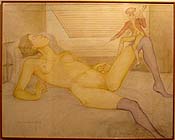November 26, 2004
Klossowski, the Body and Language
Personalising the Klossowski material is a good way into it... especially given that he is addressing the manner in which Nietzsche was able to communicate his own experience (emotional and valitudinary) in writing. The unconscious/ conscious distinction is one way of approaching Klossowski's schema. Or, alternatively, it can be divided into the body and language—which more or less align to unconscious/conscious for both Klossowski and Nietzsche anyway. The code of everyday signs [le code des signes quotidiens] is language, and so average, exchangable between every member of one's cultural group. It thus compromises the individuality of the body's experience, favouring (or empowering) the average instincts: that is, those concerned with the survival of the group. From the perspective of consciousness, or the code of everyday signs, it is difficult to experience the body's uniqueness—or whatever sets it apart from the group... And it is especially difficult to express extreme or intense bodily/emotional states (hohe -Gefüle or -Stimmungen). Thus, Klossowski is interested in how Nietzsche was able to find a sign (the eternal return) that could depict his own experience, albeit (or perhaps necessarily) in a veiled manner. The eternal return is, according to Klossowski, Nietzsche's 'phantasm': an obsessional image that conveys his most dominant impulse, and a touch-stone to which his writing returns, again and again.

Pierre Klossowski
Roberte and Gulliver (ca. 1978)
We could see Klossowski's own phantasm as expressed in his artwork , which often depicts a woman, Roberte, exhibiting herself. This phantasm is elaborated in writing in his novel Roberte Ce Soir, although I have to admit that I find this less interesting than his work on Nietzsche and Sade.
Posted by Jo Faulkner at November 26, 2004 11:32 AM | TrackBackJOe,
One of the reasons I am offside with Klossowski's reading of Nietzsche is the duality used. Your describe it well"
"The unconscious/ conscious distinction is one way of approaching Klossowski's schema. Or, alternatively, it can be divided into the body and language—which more or less align to unconscious/conscious for both Klossowski and Nietzsche anyway."
I appreciate that this returns to Freud's idea of the human self, or subject, as radically split, divided between the two realms of conscious and unconscious. I have little problem with Freud's (and psychoanalysis in general) argument that our actions, thought, belief, and the concepts of "self" are all driven and/or shaped by the unconscious, and its drives and desires.
Fine. I read Freud's notion of the unconscious as one of the ways to begin to question, undermine and destabilize the humanist conception of the stable self. I'm happy to accept that the unconscious is the ground of our being.
However, it seems to be that the unconscious/body is social and historical and so embody language not a biological organism. Language is working here far more so than an 'image' or a 'phantasm.'
What I have in mind here is Freud's account of the two main mechanisms of unconscious processes, namely condensation and displacement. Are these not essentially linguistic phenomena, where meaning is either condensed (in metaphor) or displaced (in metonymy). Did not Freud's dream analyses, and most of his analyses of the unconscious symbolism used by his patients, depend on word-play--on puns, associations, etc. that are verbal and visual.
So i would go along with Lacan here to say that that the contents of the unconscious are acutely aware of language, and particularly of the structure of language.
I presume Melanie Klein does not?
Posted by: Gary Sauer-Thompson on November 26, 2004 04:36 PM